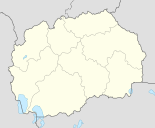Livada (North Macedonia)
| Livada Ливада Livadhia / Livadhi |
||||
|---|---|---|---|---|
|
||||
| Basic data | ||||
| Region : | southwest | |||
| Municipality : | Struga | |||
| Coordinates : | 41 ° 14 ' N , 20 ° 43' E | |||
| Height : | 710 m. i. J. | |||
| Residents : | 1,485 (2002) | |||
| Telephone code : | (+389) 046 | |||
| Postal code : | 6338 | |||
| License plate : | SU | |||
Livada ( macedonian Ливада ; albanian determined: Livadhia , indeterminate: Livadhi , the local gegischen determined dialect Livadhëja undetermined Livadhëj ) is a village in the Struga Municipality in the southwest Nordmazedoniens . It is located in the east of the Struga plain , which connects to the north of Lake Ohrid and is traversed by the Black Drin in the west . The Sateska flows southeast of Livada .
population
Livada has 2,021 inhabitants who lived in 393 households. (Status: 2019). These were ethnically seen 2,017 Muslim Albanians to 4 belonged to other ethnic groups.
Outline and traffic
Livada consists of a northern and a southern part of the village. Both are separated by undeveloped meadows and connected by a road. Livada has direct road connections with the neighboring villages of Delogoždi in the north, Korošišta in the northeast, Volino in the southeast, Draslajca in the southwest and Bidževo in the west.
It is around eight kilometers via Draslajca to the municipal capital Struga.
Education and health
The elementary school is located between the two parts of the village and is attended by students up to eighth grade. Albanian pupils from neighboring villages also come to this schoolhouse. Livada also has a small polyclinic.
Culture
The Albanian cultural and artistic association "Drita" is one of the best known in the Struga region. His folklore dance group has performed at various festivals. The “Dinamo” football club is also very popular in the village.
There is a bust of Skanderbeg across from the primary school .
economy
The majority of the workforce is employed in agriculture and animal husbandry . The areas surrounding the village are actively used for this branch of industry. However, agricultural activities have declined rapidly since the fall of Yugoslavia . As a result and because of the high unemployment, the majority have emigrated . A small part works in trade and industry.
Web links
- Brief information about Livada (Albanian)
Individual evidence
- ↑ a b Results of the 2002 census in Macedonia. In: State Statistics Office. Retrieved on May 21, 2014 (English, PDF file, 2.18 MB).


